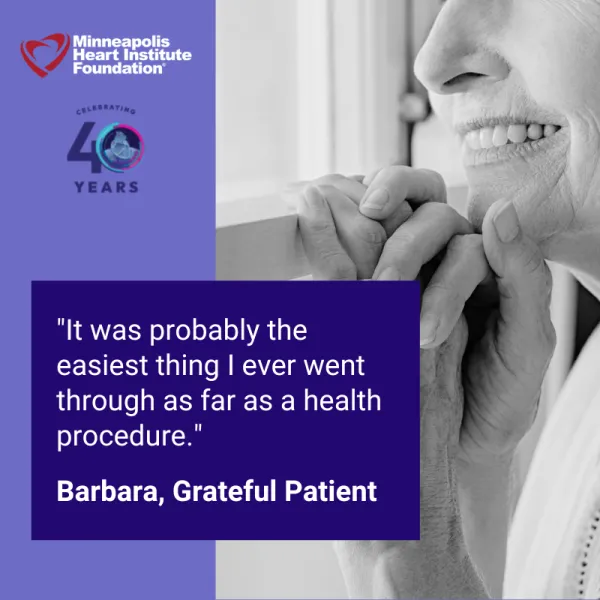Barbara Howell: Aortic Valve Replacement

At age 88, Barbara Howell was initially a little indecisive about getting her aortic valve replaced. She’d had a heart murmur for several years and knew that a series of echocardiograms over the period of a year showed the condition of her aortic valve was worsening, but she didn’t have significant symptoms and was otherwise in good health. She would get tired throughout the day and need naps and wouldn’t sleep well at night, but thought that was a pretty normal part of aging.
When doctors told Barbara she would probably only live another two years without a replacement, she began to reconsider. Her children reassured her that there wasn’t any reason she shouldn’t do it, and she wanted to maintain her good health and stay strong for her husband, who was 92 and has his own heart issues.
In September 2021, Barbara underwent a transcatheter aortic valve replacement (TAVR) at Abbott Northwestern Hospital performed by Dr. Santiago Garcia, an interventional cardiologist and researcher in the Valve Science Center at the Minneapolis Heart Institute Foundation® (MHIF).
“It was probably the easiest thing I ever went through as far as a health procedure,” said Barbara. “I was so impressed with how well they prepared me for it. They told me exactly what was involved and how long it would be. I can’t speak highly enough about the staff and Dr. Santiago and his team. It went even better than I thought.”
Through their work in MHIF’s Valve Science Center, Dr. Garcia and other researchers are industry leaders in minimally invasive, non-surgical valve repair and replacement. The transcatheter valve replacement procedure is much less risky than traditional open-heart surgery, which gives older patients like Barbara more options. Surgeons use a small incision in the leg to insert a small guidewire and catheter containing a replacement valve that is carefully guided through the blood vessels into the right position in the heart. After the minimally invasive procedure, patients are typically able to leave the hospital within one or two days.
Ten days after the procedure, Barbara felt she was recovering “exceedingly well.” She started the cardiac rehabilitation program at her local hospital and looked forward to getting stronger every day. She quickly noticed a big improvement in her sleep.
“Now I feel I can go all day and when I go bed, I get more restful sleep,” she said. “I marvel at Dr. Garcia’s expertise in performing this delicate procedure. I am deeply grateful to him and his team for all they did to assure this success and improve and extend my life journey.”

